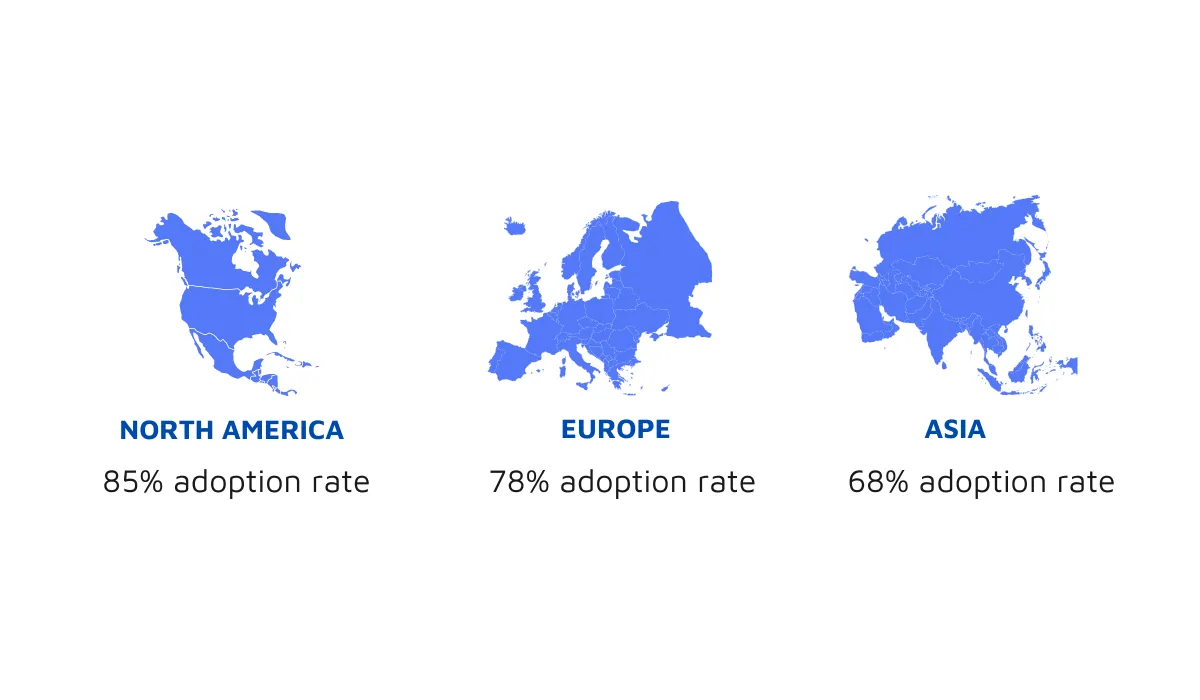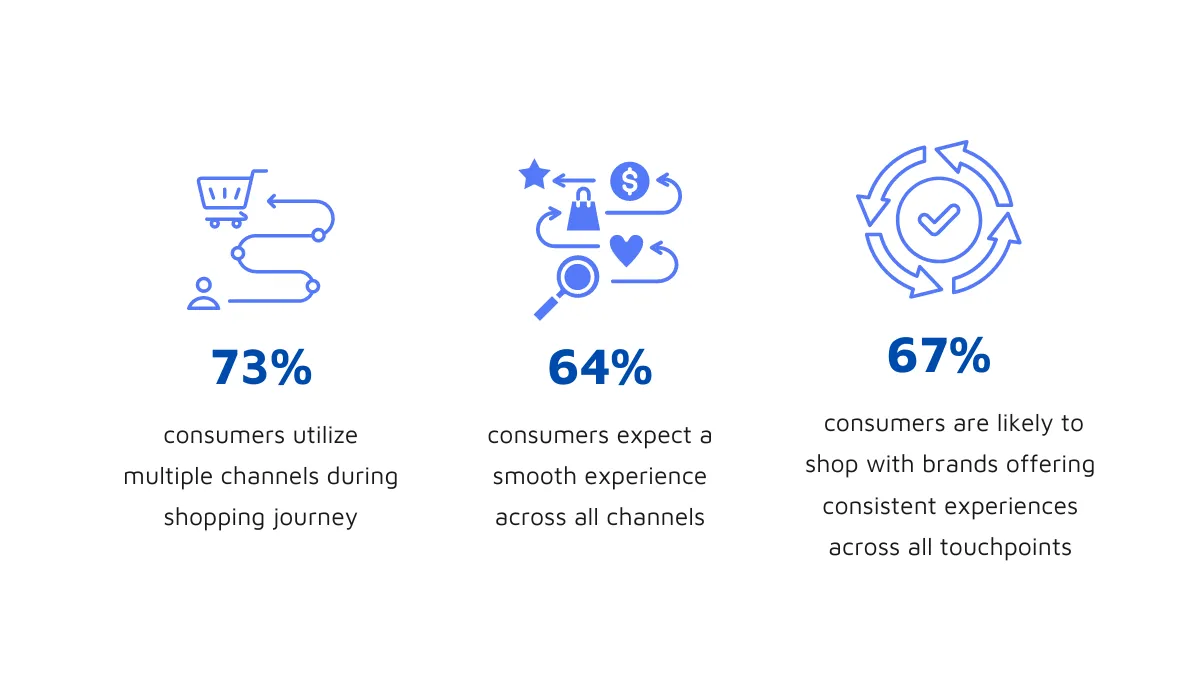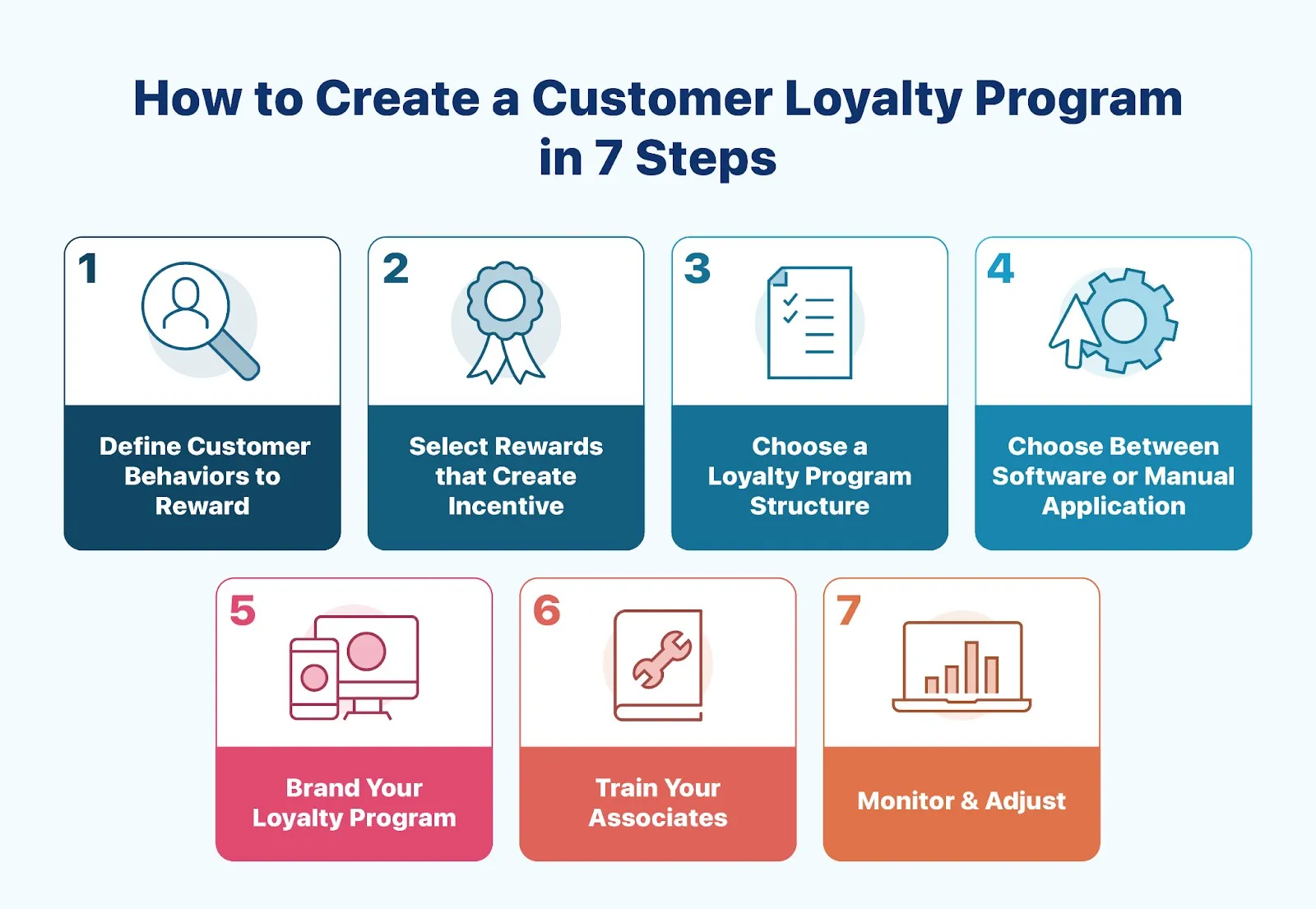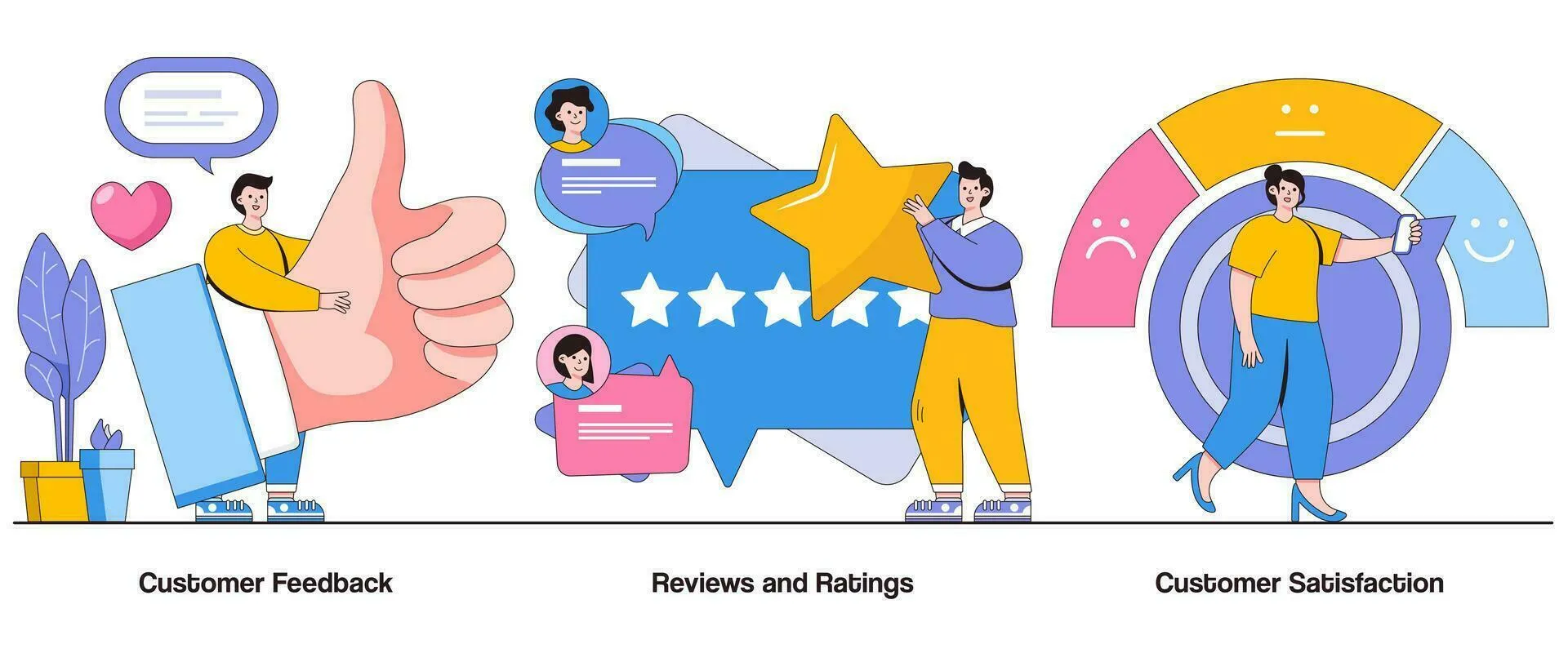Omnichannel retail statistics highlight a profound impact on both consumer behavior and business performance. For consumers, omnichannel retail offers unparalleled convenience, personalized experiences, and greater flexibility in their shopping journeys. They can start their shopping process on one platform and seamlessly transition to another, reflecting the way people live and shop today. This level of convenience enhances customer satisfaction and loyalty, driving repeat purchases and fostering long-term relationships.
For businesses, the implementation of omnichannel retail strategies is a powerful catalyst for growth. Omnichannel retail statistics reveal that companies adopting these strategies often see higher revenue growth, improved customer retention rates, and better insights into customer preferences through data integration across channels. By leveraging data from various touchpoints, businesses can create more targeted marketing campaigns, optimize inventory management, and enhance overall operational efficiency.
Table of Contents
Current State of Omnichannel Retail
Global Adoption Rates
The current state of omnichannel retail is marked by widespread adoption and continuous growth across various regions. Omnichannel retail statistics provide a comprehensive overview of how businesses worldwide are embracing this strategy to stay competitive and meet consumer expectations.
Statistics on Global Adoption of Omnichannel Strategies
Globally, the adoption of omnichannel strategies has seen a significant upward trajectory. According to recent omnichannel retail statistics, approximately 73% of consumers now use multiple channels during their shopping journey. This shift reflects a fundamental change in consumer behavior, driven by the desire for convenience, flexibility, and personalized experiences.
Businesses have responded to this trend by integrating their online and offline operations to create a seamless shopping experience. For instance, a 2023 survey conducted by Harvard Business Review found that 62% of retailers worldwide have implemented some form of omnichannel strategy, such as click-and-collect services, online-to-offline (O2O) marketing, and unified customer service systems.
Moreover, omnichannel retail statistics indicate that companies with robust omnichannel strategies achieve an average customer retention rate of 89%, compared to 33% for those with weak omnichannel approaches. This stark contrast underscores the critical role that omnichannel strategies play in fostering customer loyalty and driving repeat business.
Comparison of Adoption Rates by Region
North America:
North America leads the way in the adoption of omnichannel strategies. According to omnichannel retail statistics, approximately 85% of North American retailers have implemented omnichannel solutions. This high adoption rate is driven by a mature eCommerce market, advanced technological infrastructure, and a consumer base that demands seamless integration between online and offline shopping experiences.
For example, major retailers like Walmart and Target have heavily invested in omnichannel capabilities, such as curbside pickup, same-day delivery, and mobile app integrations. These efforts have resulted in significant increases in customer satisfaction and sales, with Target reporting a 34% increase in digital sales in 2023 due to its omnichannel initiatives.

Europe:
Europe also demonstrates strong adoption of omnichannel strategies, although at a slightly lower rate than North America. Omnichannel retail statistics show that around 78% of European retailers have embraced omnichannel approaches. The adoption is particularly prominent in countries like the United Kingdom, Germany, and France, where eCommerce penetration is high.
European retailers are increasingly focusing on creating unified shopping experiences through technologies like augmented reality (AR) for virtual try-ons, seamless cross-channel returns, and personalized marketing. For instance, UK-based retailer John Lewis reported a 45% increase in online sales following the implementation of a comprehensive omnichannel strategy that includes virtual shopping assistance and integrated loyalty programs.
Asia:
Asia is a rapidly growing market for omnichannel retail, with adoption rates varying significantly across the region. Omnichannel retail statistics reveal that about 68% of Asian retailers have adopted omnichannel strategies, with higher rates in developed markets like Japan, South Korea, and China.
In China, leading eCommerce giants like Alibaba and JD.com are at the forefront of omnichannel innovation. Alibaba’s “New Retail” concept seamlessly blends online and offline channels, providing consumers with a holistic shopping experience. This approach has led to substantial growth, with omnichannel retail statistics indicating a 52% increase in sales for Alibaba’s brick-and-mortar stores integrated with its online platforms.
Conversely, in emerging markets within Asia, the adoption of omnichannel strategies is still in its nascent stages but is expected to grow rapidly as digital infrastructure improves and consumer behavior shifts towards integrated shopping experiences.
Market Size and Growth
Current Market Size of Omnichannel Retail
As of 2024, the global omnichannel retail market is valued at approximately $5.9 trillion. This figure represents a significant increase from previous years, demonstrating the rapid adoption and implementation of omnichannel strategies across various retail sectors. The market size is projected to continue its upward trajectory. According to retail omnichannel statistics, this market size has been propelled by the integration of digital and physical shopping experiences, which cater to the evolving preferences of today’s consumers.
Several key factors contribute to the substantial market size and growth of omnichannel retail:
- Consumer Demand for Seamless Experiences: Consumers increasingly expect seamless and integrated shopping experiences across all channels. Omnichannel retail statistics show that 73% of consumers use multiple channels during their shopping journey, highlighting the necessity for retailers to meet these expectations.
- Technological Advancements: The proliferation of advanced technologies such as artificial intelligence (AI), machine learning, augmented reality (AR), and the Internet of Things (IoT) has enabled retailers to create more personalized and cohesive shopping experiences. These technologies facilitate better inventory management, customer engagement, and data integration, driving the adoption of omnichannel strategies.
- eCommerce and Mobile Commerce Growth: The exponential growth of eCommerce and mobile commerce has been a significant driver of the omnichannel retail market. With more consumers shopping online and via mobile devices, retailers are compelled to integrate these digital channels with their physical stores to provide a unified experience.
- Shift in Retailer Strategies: Retailers are increasingly recognizing the importance of omnichannel strategies in staying competitive. Investments in omnichannel capabilities, such as click-and-collect services, curbside pickup, and integrated loyalty programs, are becoming standard practices among leading retailers.
With a global valuation of $5.9 trillion and robust growth projections, the omnichannel retail market is set to play an increasingly pivotal role in shaping the future of commerce. As retailers continue to invest in omnichannel strategies and leverage advanced technologies to meet consumer demands, the market is poised for sustained expansion, offering numerous opportunities for growth and innovation.
Regional Market Insights
The market size and growth of omnichannel retail vary across different regions, reflecting the diverse levels of adoption and technological infrastructure.
- North America: North America is the largest market for omnichannel retail, accounting for approximately 35% of the global market share. The region’s market size is currently valued at around $2.1 trillion. The high adoption rates of omnichannel strategies, coupled with advanced technological infrastructure and a consumer base that demands seamless experiences, drive this substantial market size.
- Europe: Europe follows North America in terms of market size, with a valuation of about $1.7 trillion. The region’s growth is fueled by significant investments in digital transformation and the increasing popularity of eCommerce. Countries like the United Kingdom, Germany, and France are leading the way in omnichannel adoption, contributing to the overall market expansion.
- Asia-Pacific: The Asia-Pacific region is the fastest-growing market for omnichannel retail, with a current market size of approximately $1.5 trillion. The region’s growth is driven by the rapid digitalization of retail, particularly in China, Japan, and South Korea. The rising middle class, increasing smartphone penetration, and innovative retail strategies by major eCommerce players are key factors propelling market growth in this region.
- Latin America and Middle East & Africa: These regions, although smaller in market size compared to North America, Europe, and Asia-Pacific, are experiencing steady growth. The Latin American market is valued at around $400 billion, while the Middle East & Africa market stands at approximately $200 billion. As digital infrastructure improves and consumer behavior shifts towards online and integrated shopping experiences, the market size in these regions is expected to grow significantly.
Projected Growth Rates and Future Trends
Looking ahead, the global omnichannel retail market is projected to continue its robust growth, with an estimated compound annual growth rate (CAGR) of 14.1% over the next five years. By 2029, the market is expected to reach approximately $10.2 trillion, driven by ongoing technological advancements, changing consumer behaviors, and increased investments in omnichannel infrastructure.
Several trends are expected to shape the future of omnichannel retail:
- Enhanced Personalization and AI Integration: Retailers will increasingly use AI and machine learning to offer personalized shopping experiences. Omnichannel marketing trends predict that AI-driven personalization will lead to higher conversion rates and improved customer retention.
- Augmented Reality and Virtual Reality: The use of AR and VR in retail will become more prevalent, allowing customers to visualize products in their environment before making a purchase. This trend is expected to enhance the omnichannel customer experience significantly.
- Greater Emphasis on Mobile Commerce: Mobile commerce will continue to grow, with more retailers optimizing their mobile apps and websites for seamless shopping experiences. Omnichannel customer service statistics show that mobile-friendly customer service options will become a standard expectation.
- Expansion of Click-and-Collect Services: Click-and-collect services will expand, providing customers with more convenient options for picking up online orders from physical locations. This service enhances the omnichannel experience by combining the benefits of online shopping with the immediacy of in-store pickup.
- Integration of IoT for Smart Retailing: The Internet of Things will play a significant role in smart retailing, enabling real-time inventory management, personalized marketing, and enhanced in-store experiences. Retail omnichannel statistics suggest that IoT integration will streamline operations and improve the overall efficiency of retail businesses.
Key Omnichannel Retail Statistics
Customer Preferences and Behavior
This section delves into key statistics that highlight how customers interact with different channels, their preferences for omnichannel experiences, and the impact of these interactions on overall satisfaction and loyalty.
Statistics on Customer Preferences for Omnichannel Experiences
Customer preferences are evolving rapidly, with a clear trend toward seamless, integrated shopping experiences. According to recent omnichannel retail statistics, approximately 73% of consumers use multiple channels during their shopping journey. This statistic underscores the growing demand for a cohesive shopping experience that allows customers to move effortlessly between online, mobile, and in-store environments.

Omnichannel customer experience statistics further reveal that 64% of consumers expect a seamless experience across all channels, whether they are shopping online, on mobile apps, or in physical stores. This expectation is driven by the convenience and flexibility that omnichannel shopping provides, enabling customers to research products online, make purchases through mobile apps, and pick up orders in-store.
Additionally, omnichannel marketing statistics highlight that 67% of consumers are more likely to shop with brands that offer a consistent experience across all channels. This statistic underscores the importance of maintaining a unified brand presence and customer experience, reinforcing the need for retailers to invest in integrated omnichannel strategies.
How Customers Interact with Various Channels
Online Channels:
- Consumer Behavior: Omnichannel customer experience statistics show that 81% of consumers conduct online research before making a purchase, indicating the importance of a strong online presence. This includes browsing product reviews, comparing prices, and checking availability.
- Mobile Usage: Mobile devices are a crucial component of the omnichannel experience, with 62% of consumers using smartphones to research products and make purchases. Omnichannel marketing statistics suggest that mobile-optimized websites and apps are essential for capturing this segment of the market.
In-Store Interactions:
- Integration with Digital: Retail omnichannel statistics indicate that 55% of shoppers use their smartphones in-store to check prices, read reviews, and access promotions. This highlights the need for retailers to integrate digital elements into the physical store experience, such as interactive displays, digital price tags, and in-store Wi-Fi.
- Click-and-Collect: Data on click-and-collect services reveal that 56% of consumers prefer this option for online purchases, as it offers the convenience of picking up orders in-store without shipping fees. Retailers who implement efficient click-and-collect systems see higher customer satisfaction and increased in-store traffic.
Mobile Channels:
- App Usage: Omnichannel customer service statistics show that 70% of consumers use retail apps to make purchases, access promotions, and receive customer support. This underscores the importance of developing user-friendly, feature-rich mobile apps that enhance the shopping experience.
- Location-Based Services: The use of location-based services is growing, with 45% of consumers willing to share their location for personalized offers and in-store promotions. Retailers can leverage this data to provide relevant, timely offers, enhancing customer engagement and loyalty.
Social Media Engagement:
- Influence on Purchasing Decisions: Omnichannel retail statistics reveal that 58% of consumers are influenced by social media when making purchasing decisions. This underscores the importance of a strong social media presence and the integration of social media marketing with other channels.
- Customer Service on Social Media: Omnichannel customer service statistics indicate that 53% of consumers expect to receive customer support through social media channels. Retailers who provide responsive, helpful customer service on platforms like Facebook, Twitter, and Instagram enhance their brand reputation and customer satisfaction.
The key omnichannel retail statistics underscore the critical role of seamless, integrated shopping experiences in meeting customer expectations and driving business growth. Consumers today demand consistency and convenience across all channels, whether shopping online, via mobile apps, or in physical stores.
Retailers who leverage these insights to develop cohesive, customer-centric strategies are more likely to enhance their omnichannel customer experience, boost customer loyalty, and achieve sustained success in the competitive retail landscape. By continuing to monitor and adapt to these evolving preferences, retailers can ensure that their omnichannel strategies remain effective and aligned with consumer needs.
Sales and Revenue Impact
Impact of Omnichannel Strategies on Sales and Revenue
Omnichannel retail statistics reveal a notable positive impact on sales and revenue for retailers that embrace these strategies. Companies with comprehensive omnichannel customer engagement strategies report retaining 89% of their customers, compared to 33% for those with weak omnichannel approaches. This significant retention rate directly correlates with higher sales and long-term revenue growth, underscoring the importance of a unified customer experience.
According to omnichannel marketing statistics, retailers that implement omnichannel strategies experience an average revenue growth of 23% higher than those that do not. This increase is largely attributed to the ability of omnichannel strategies to provide personalized and consistent customer experiences across all touchpoints, including online, mobile, and in-store interactions.

Further, omnichannel customer experience statistics indicate that 86% of shoppers are willing to pay up to 25% more for a superior customer experience. By delivering a seamless and cohesive shopping journey, retailers can capitalize on this willingness to spend more, thereby boosting their overall revenue.
Moreover, omnichannel customer service statistics highlight the critical role of integrated customer support in driving sales. Retailers offering unified customer service across channels report a 30% increase in customer satisfaction, leading to higher repeat purchase rates and increased revenue.
ROI and Profit Statistics
The return on investment (ROI) and profit statistics for omnichannel strategies further emphasize their financial benefits. Retailers that have adopted omnichannel approaches report a significant ROI due to increased sales, improved customer retention, and enhanced operational efficiency.
- Enhanced Customer Lifetime Value (CLV): Omnichannel retail statistics show that customers who engage with multiple channels have a 30% higher lifetime value compared to those who shop through a single channel. This higher CLV translates to increased revenue over time, justifying the investment in omnichannel strategies.
- Increased Average Order Value (AOV): Retailers employing omnichannel strategies often see an increase in average order value. According to omnichannel marketing statistics, AOV is typically 13% higher for omnichannel shoppers. This increase is driven by the convenience and personalized recommendations that omnichannel experiences provide.
- Reduced Operational Costs: Omnichannel strategies can also lead to reduced operational costs through better inventory management and streamlined logistics. By integrating online and offline channels, retailers can optimize stock levels, reduce overstock and stockouts, and improve supply chain efficiency.
- Higher Conversion Rates: Omnichannel customer experience statistics reveal that conversion rates are significantly higher when customers engage through multiple channels. Retailers report a 20% higher conversion rate for omnichannel shoppers, reflecting the effectiveness of providing a cohesive shopping experience.
- Improved Profit Margins: The combination of increased sales, higher AOV, and reduced operational costs contributes to improved profit margins. Retailers with strong omnichannel strategies report profit margins up to 15% higher than those relying solely on single-channel approaches.
Customer Retention and Loyalty
Statistics on Customer Retention Rates with Omnichannel Strategies
Customer retention is a vital metric for any retail business, as retaining existing customers is often more cost-effective than acquiring new ones. Omnichannel retail statistics consistently highlight the superior retention rates achieved by businesses that adopt omnichannel strategies compared to those that rely solely on single-channel approaches.
According to recent studies, companies with strong omnichannel customer engagement strategies retain 89% of their customers, whereas businesses with weak omnichannel approaches retain only 33%. This stark contrast underscores the importance of a cohesive and integrated shopping experience in fostering customer loyalty. When customers can seamlessly transition between online, mobile, and in-store interactions, they are more likely to return for future purchases.
Further, omnichannel marketing statistics reveal that 90% of customers expect consistent interactions across channels. When businesses meet this expectation, they not only enhance customer satisfaction but also significantly improve retention rates. Customers value the ability to interact with a brand through their preferred channels without encountering disruptions or inconsistencies. For example, a customer might research a product online, check its availability on a mobile app, and make the final purchase in-store. The smooth integration of these experiences builds trust and encourages repeat business.
Moreover, omnichannel customer experience statistics indicate that personalized interactions, a hallmark of effective omnichannel strategies, play a crucial role in retention. Personalized marketing, tailored recommendations, and customized customer service enhance the shopping experience, making customers feel valued and understood. This personalized approach is reflected in higher retention rates, as customers are more likely to remain loyal to brands that cater to their individual preferences and needs.
The impact of omnichannel strategies on retention is also evident in customer feedback and reviews. Retailers that implement omnichannel approaches often see higher ratings and positive reviews, further reinforcing customer loyalty. According to omnichannel customer service statistics, businesses that offer integrated and responsive customer support across all channels report a 30% increase in customer satisfaction. This heightened satisfaction translates into greater loyalty and retention, as customers appreciate the consistent and efficient support they receive.
Statistics on Loyalty Programs in Omnichannel Retail
Loyalty programs are a powerful tool in the arsenal of omnichannel retail strategies. These programs incentivize repeat purchases and foster long-term relationships by rewarding customers for their loyalty. Omnichannel retail statistics provide compelling evidence of the effectiveness of loyalty programs in driving customer retention and loyalty.
According to a report by Bond, 79% of consumers say loyalty programs make them more likely to continue doing business with brands. This statistic is even more pronounced in an omnichannel context, where loyalty programs can be seamlessly integrated across various touchpoints. Customers can earn and redeem rewards whether they shop online, via mobile apps, or in physical stores, enhancing the overall value and convenience of the loyalty program.
Omnichannel marketing statistics reveal that 83% of consumers are more likely to participate in a loyalty program that offers a unified experience across all channels. This preference highlights the importance of designing loyalty programs that are accessible and rewarding, regardless of how or where customers choose to shop. For example, a customer might earn points for online purchases and then redeem those points for discounts during an in-store visit, reinforcing the interconnectedness of the shopping experience.

Moreover, loyalty programs in omnichannel retail often leverage advanced data analytics to personalize rewards and offers. Omnichannel customer experience statistics show that 77% of consumers are more likely to stay with brands that offer personalized rewards. By analyzing customer behavior across different channels, retailers can tailor loyalty program benefits to individual preferences, increasing engagement and satisfaction. Personalized offers, exclusive discounts, and tailored recommendations make customers feel appreciated and incentivize continued loyalty.
The effectiveness of omnichannel loyalty programs is further supported by their impact on customer spending. According to omnichannel retail statistics, customers enrolled in loyalty programs spend 12-18% more than those who are not members. This increased spending is driven by the perceived value of the rewards and the seamless integration of the loyalty program across all channels. Customers are more likely to make frequent and higher-value purchases when they know they are earning points or rewards that can be easily redeemed.
Additionally, loyalty programs that integrate omnichannel customer service statistics see a significant boost in customer engagement. For instance, loyalty program members often receive priority customer support, exclusive access to sales, and personalized shopping experiences, further enhancing their satisfaction and loyalty. Retailers that provide a cohesive and rewarding loyalty program experience across all channels can foster deeper connections with their customers, driving long-term retention and brand loyalty.
The role of customer retention and loyalty programs
The impact of omnichannel strategies on customer retention and loyalty is unequivocally positive, as demonstrated by various omnichannel retail statistics. Businesses that adopt comprehensive omnichannel approaches achieve significantly higher retention rates and foster greater customer loyalty compared to those that do not. The seamless integration of online, mobile, and in-store experiences ensures that customers can interact with brands consistently and conveniently, building trust and encouraging repeat business.
Loyalty programs, when effectively integrated into omnichannel strategies, further enhance customer retention and loyalty. By offering personalized rewards and a unified experience across all channels, retailers can incentivize repeat purchases and strengthen long-term relationships with their customers. The compelling evidence provided by omnichannel marketing statistics, omnichannel customer experience statistics, and omnichannel customer service statistics underscores the critical importance of these strategies in driving sustained business success.
As the retail landscape continues to evolve, businesses must prioritize the implementation of omnichannel strategies and loyalty programs to meet the ever-changing expectations of their customers. By doing so, they can ensure higher retention rates, increased customer loyalty, and ultimately, greater revenue and profitability. The future of retail lies in the ability to provide a seamless, integrated, and personalized shopping experience that resonates with customers across all touchpoints.
Conversion Rates
Omnichannel strategies have a profound impact on conversion rates, driving significant improvements across various channels.
Comparison of Conversion Rates Across Different Channels
Conversion rates can vary significantly depending on the channel through which customers interact with a retailer. Understanding these differences is essential for developing effective omnichannel strategies that optimize performance across all touchpoints.

Online Channels:
- Desktop: Retail omnichannel statistics show that desktop conversion rates are generally higher than those of other online channels. This is often due to the larger screen size and the ease of navigating comprehensive websites. According to recent data, average conversion rates for desktop users range from 2.5% to 3.5%.
- Mobile: Mobile conversion rates tend to be lower than desktop rates, typically ranging from 1.5% to 2.5%. The smaller screen size, slower loading times, and potential for more distractions can hinder the mobile shopping experience. However, mobile remains a crucial channel for initial customer engagement and research.
- Tablet: Tablets usually have conversion rates that fall between desktop and mobile, averaging around 2% to 3%. The larger screen size compared to mobile provides a better user experience, but it still lacks the comprehensive functionality of desktops.
In-Store Channels:
Conversion rates in physical stores are typically higher than online channels, with in-store rates often exceeding 20%. The ability to physically interact with products, receive immediate customer service, and complete purchases without waiting for delivery contributes to these higher rates. Omnichannel customer experience statistics highlight the importance of in-store interactions for driving immediate sales.
Omnichannel Integration:
The integration of online and offline channels through omnichannel strategies can lead to substantial improvements in overall conversion rates. Omnichannel marketing statistics reveal that businesses employing omnichannel approaches can achieve conversion rates up to 20% higher than those relying on single-channel strategies. This increase is driven by the seamless customer journey that omnichannel retail provides, allowing customers to move effortlessly between different touchpoints.
How Omnichannel Strategies Improve Conversion Rates
The implementation of omnichannel strategies significantly enhances conversion rates by providing a cohesive and personalized shopping experience. Several key factors contribute to these improvements, as evidenced by various omnichannel retail statistics.
- Personalized Customer Experiences: Omnichannel strategies leverage data from multiple channels to create personalized shopping experiences. Personalized recommendations, targeted marketing campaigns, and customized promotions resonate more with customers, increasing the likelihood of conversion. Omnichannel marketing statistics indicate that personalized marketing can boost conversion rates by up to 10%. For instance, a customer who receives product recommendations based on their browsing history across devices is more likely to make a purchase.
- Seamless Cross-Channel Journeys: Customers often interact with multiple channels before making a purchase. Omnichannel strategies ensure that this journey is seamless, reducing friction and enhancing the overall experience. Omnichannel customer experience statistics show that customers who have a smooth cross-channel journey are 20% more likely to convert. This might involve researching a product on a mobile device, receiving a personalized email offer, and completing the purchase in-store.
- Integrated Customer Service: High-quality customer service is crucial for conversion. Omnichannel customer service statistics reveal that integrated support across channels can increase customer satisfaction and conversion rates. Customers value the ability to receive assistance regardless of how they choose to interact with a brand—whether via chat on a website, through social media, or in-person at a store. Retailers that provide consistent and responsive customer service across all touchpoints report a 15% higher conversion rate.
- Click-and-Collect Services: Click-and-collect services, where customers purchase online and pick up in-store, exemplify the benefits of omnichannel integration. This service offers the convenience of online shopping combined with the immediacy of in-store pickup. Retail omnichannel statistics indicate that click-and-collect customers have a 30% higher conversion rate compared to those who only shop online. Additionally, these customers often make additional purchases when they visit the store to collect their items, further boosting sales.
- Consistent Brand Messaging: Maintaining consistent brand messaging across all channels reinforces trust and encourages conversions. Customers are more likely to convert when they receive a unified message and experience from a brand, regardless of the channel. Omnichannel marketing statistics show that consistent branding can increase conversion rates by up to 23%. This consistency helps build a strong brand identity and ensures that customers know what to expect at every touchpoint.
- Real-Time Inventory Management: Omnichannel strategies that integrate real-time inventory management enhance the shopping experience by ensuring product availability. Customers can check online to see if an item is in stock at a nearby store, increasing the likelihood of a visit and subsequent purchase. Omnichannel retail statistics demonstrate that real-time inventory visibility can improve conversion rates by up to 15%, as it reduces the frustration of encountering out-of-stock items.
- Enhanced Mobile Experience: Improving the mobile shopping experience is a critical component of successful omnichannel strategies. Mobile optimization, including faster load times, user-friendly interfaces, and secure payment options, can significantly boost conversion rates. Omnichannel customer experience statistics highlight that a well-optimized mobile site or app can increase mobile conversion rates by up to 50%. Retailers that focus on enhancing their mobile platforms can capture a larger share of the growing mobile commerce market.
- Customer Loyalty Programs: Integrating loyalty programs into omnichannel strategies can drive repeat purchases and improve conversion rates. Customers who are members of loyalty programs are more likely to convert, especially when they can earn and redeem rewards across all channels. Omnichannel retail statistics indicate that loyalty program members have a 13% higher conversion rate than non-members. These programs incentivize customers to engage more frequently with the brand, leading to increased sales.
What does this mean?
The comparison of conversion rates across different channels and the data on how omnichannel strategies improve these rates underscore the significant advantages of a well-integrated retail approach. Omnichannel retail statistics clearly demonstrate that businesses adopting omnichannel strategies see substantial improvements in conversion rates, driven by personalized experiences, seamless cross-channel journeys, integrated customer service, and enhanced mobile platforms.

Retailers that prioritize omnichannel strategies can better meet customer expectations, drive higher conversion rates, and achieve greater overall success. As the retail landscape continues to evolve, the ability to provide a consistent, personalized, and integrated shopping experience across all touchpoints will be critical for staying competitive and driving sustained growth. The future of retail lies in the effective implementation of omnichannel strategies that leverage the strengths of each channel to create a cohesive and engaging customer journey.
Logistics, Distribution, and Warehouse Management
Efficient logistics, distribution, and warehouse management are pivotal in the success of omnichannel retail strategies. These elements ensure that products are available where and when customers need them, directly impacting customer satisfaction and business performance. This section explores key omnichannel retail statistics related to logistics and distribution efficiency, warehouse management improvements, delivery times and costs, and customer satisfaction related to logistics and delivery.
Statistics on Logistics and Distribution Efficiency
Effective logistics and distribution are the backbone of a successful omnichannel strategy. Retail omnichannel statistics reveal significant improvements in logistics and distribution efficiency due to the integration of omnichannel approaches.
- Optimization through Omnichannel Strategies: Omnichannel strategies optimize logistics and distribution by integrating various channels and streamlining operations. Data shows that retailers implementing omnichannel strategies experience a 15-20% improvement in logistics efficiency. This optimization is achieved through better coordination between online and offline channels, improved inventory management, and more efficient routing of goods.
- Impact of Real-Time Inventory Management: Real-time inventory management is a critical component of omnichannel logistics. By having up-to-date information on stock levels across all channels, retailers can reduce stockouts and overstock situations, leading to more efficient distribution. Omnichannel retail statistics indicate that real-time inventory management can improve logistics efficiency by up to 25%. This improvement is due to better demand forecasting, reduced lead times, and more accurate replenishment of inventory.
Warehouse Management in Omnichannel Retail
Warehouse management plays a crucial role in supporting omnichannel strategies. The ability to manage inventory effectively and fulfill orders from various channels can significantly impact a retailer’s ability to meet customer expectations.
- Improvements with Omnichannel Strategies: Omnichannel retail statistics show that implementing omnichannel strategies leads to significant improvements in warehouse management. Retailers report a 30% increase in warehouse efficiency due to the integration of omnichannel approaches. This efficiency is achieved through better inventory tracking, optimized storage solutions, and streamlined order fulfillment processes.
- Technologies: Advanced technologies such as warehouse management systems (WMS) and automated storage and retrieval systems (AS/RS) are instrumental in enhancing warehouse efficiency. These technologies enable faster order processing, reduce errors, and improve overall warehouse productivity.
Impact on Delivery Times and Costs
Timely and cost-effective delivery is a critical factor in customer satisfaction and overall business performance. Omnichannel logistics strategies have a profound impact on delivery times and costs.
Delivery Times
- Omnichannel logistics strategies significantly reduce delivery times by optimizing the fulfillment process. Retail omnichannel statistics reveal that retailers with strong omnichannel strategies can reduce delivery times by up to 30%. This reduction is achieved through better inventory placement, efficient routing, and the ability to fulfill orders from the nearest location.
- Same-day and next-day delivery options are becoming increasingly common in omnichannel retail. By leveraging local stores as distribution hubs, retailers can meet the growing demand for fast delivery. Omnichannel marketing statistics show that 65% of consumers expect same-day or next-day delivery, highlighting the importance of efficient logistics in meeting customer expectations.
Cost Savings
- Omnichannel approaches also lead to significant cost savings in logistics. Retailers can reduce transportation costs by optimizing delivery routes and consolidating shipments. Omnichannel retail statistics indicate that retailers can achieve a 20% reduction in logistics costs through effective omnichannel strategies.
- Cross-channel fulfillment, such as ship-from-store and buy online, pick up in store (BOPIS), helps reduce shipping costs and improve delivery efficiency. By using physical stores as fulfillment centers, retailers can minimize the distance products need to travel, thereby lowering transportation costs and speeding up delivery times.
Customer Satisfaction Related to Logistics and Delivery
Customer satisfaction is closely tied to the efficiency of logistics and delivery processes. Retailers that excel in these areas often see higher levels of customer satisfaction and loyalty.
Satisfaction with Delivery Times and Accuracy
- Omnichannel customer experience statistics highlight that timely and accurate delivery is a key driver of customer satisfaction. Retailers that implement efficient omnichannel logistics report a 25% increase in customer satisfaction related to delivery times and accuracy.
- Customers value reliability and predictability in delivery. Omnichannel customer service statistics show that 80% of customers consider timely delivery as a crucial factor in their overall shopping experience. Retailers that consistently meet delivery expectations are more likely to retain customers and receive positive reviews.
Impact of Real-Time Tracking and Transparency
- Providing real-time tracking and transparency in the delivery process further enhances customer satisfaction. Retail omnichannel statistics reveal that 70% of customers appreciate real-time updates on their order status. This transparency builds trust and keeps customers informed, reducing anxiety about their purchases.
- Retailers that offer real-time tracking and proactive communication about delivery status see a significant increase in customer satisfaction. Customers appreciate knowing exactly when their orders will arrive and being informed about any potential delays.
Returns and Reverse Logistics
- Efficient returns and reverse logistics processes are also critical to customer satisfaction. Omnichannel strategies that streamline returns and make the process hassle-free contribute to higher customer loyalty. Retailers that offer convenient return options, such as in-store returns for online purchases, report a 15% increase in customer satisfaction.
- Omnichannel retail statistics indicate that customers who have a positive returns experience are more likely to make repeat purchases. Retailers that handle returns efficiently and provide excellent customer service during the process can turn potentially negative experiences into opportunities to build customer loyalty.
Omnichannel Retail Technologies
This section delves into the adoption rates of various omnichannel technologies, such as CRM, ERP, and mobile apps, highlighting their impact on retail operations and customer experiences. By examining key omnichannel retail technologies statistics, we can better understand how these innovations drive success in the competitive retail landscape.
Technology Adoption Rates
The adoption of advanced technologies is a cornerstone of successful omnichannel retail strategies. These technologies facilitate seamless integration across various channels, enhance customer experiences, and optimize operations. This section explores key omnichannel retail statistics related to the adoption of various technologies, such as CRM, ERP, and mobile apps, and highlights the technologies driving the success of omnichannel retail.
Statistics on the Adoption of Various Technologies in Omnichannel Retail
The integration of technology in omnichannel retail has seen significant growth over the past decade. Retail omnichannel statistics indicate that retailers are increasingly investing in technologies to streamline their operations and enhance customer engagement.
- CRM Systems: CRM systems are essential for managing customer interactions and data across different channels. According to omnichannel marketing statistics, approximately 85% of retailers have adopted CRM systems to support their omnichannel strategies. These systems help retailers track customer behavior, preferences, and purchase history, enabling personalized marketing and improved customer service.
- ERP Systems: ERP systems integrate various business processes, including inventory management, order processing, and financial management. Retail omnichannel statistics show that 78% of retailers use ERP systems to ensure seamless operations across channels. By centralizing data and automating processes, ERP systems help retailers maintain real-time visibility into their inventory and streamline their supply chain operations.
- Mobile Applications: Mobile apps play a crucial role in enhancing the omnichannel customer experience. Omnichannel customer experience statistics reveal that 70% of retailers have developed mobile apps to provide a convenient shopping experience. These apps offer features such as mobile payments, personalized recommendations, and location-based services, making it easier for customers to shop on the go.
- eCommerce Platforms: Robust eCommerce platforms are foundational to omnichannel retail, providing the infrastructure for online sales and integration with other channels. Omnichannel retail statistics indicate that 92% of retailers have invested in advanced eCommerce platforms. These platforms support a range of functionalities, including product listings, shopping cart management, and order fulfillment, ensuring a seamless online shopping experience.
- POS Systems: Modern POS systems are integral to omnichannel retail, facilitating transactions across physical and digital channels. Retail omnichannel statistics show that 67% of retailers have upgraded their POS systems to support omnichannel capabilities. These systems enable features like buy online, pick up in-store (BOPIS) and in-store returns of online purchases, enhancing the flexibility and convenience for customers.
- AI and Machine Learning: AI and machine learning technologies are increasingly being adopted to personalize customer experiences and optimize operations. Omnichannel marketing statistics highlight that 53% of retailers use AI to analyze customer data and deliver personalized marketing campaigns. AI-driven chatbots and virtual assistants also improve customer service by providing instant support and recommendations.
- Augmented Reality (AR) and Virtual Reality (VR): AR and VR technologies are being used to enhance the shopping experience by allowing customers to visualize products in their environment before making a purchase. According to omnichannel customer experience statistics, 40% of retailers have integrated AR and VR into their omnichannel strategies. These technologies provide immersive experiences that can drive higher engagement and conversion rates.
Key Technologies Driving Omnichannel Retail Success
Several key technologies are pivotal in driving the success of omnichannel retail, providing the infrastructure and tools needed to deliver seamless and integrated customer experiences.
- Advanced Analytics and Big Data: Advanced analytics and big data technologies are essential for understanding customer behavior and preferences. Retailers use these tools to analyze vast amounts of data collected from various channels, enabling them to make data-driven decisions. Omnichannel retail statistics show that retailers leveraging advanced analytics can increase their revenue by up to 15% through more effective targeting and personalization.
- Cloud Computing: Cloud computing provides the scalability and flexibility needed to support omnichannel operations. By storing data and running applications in the cloud, retailers can ensure seamless integration across channels and access real-time information. According to omnichannel marketing statistics, 72% of retailers use cloud-based solutions to enhance their omnichannel capabilities. Cloud computing also facilitates collaboration and data sharing across different departments, improving overall efficiency.
- Automation and Robotics: Automation and robotics technologies streamline warehouse and fulfillment operations, reducing labor costs and increasing efficiency. Automated guided vehicles (AGVs) and robotic process automation (RPA) are used to move goods within warehouses and handle repetitive tasks. Retail omnichannel statistics show that retailers implementing automation can reduce operational costs by up to 20% while speeding up order fulfillment.
- Customer Data Platforms (CDPs): CDPs centralize customer data from various sources, providing a unified view of customer interactions. This holistic perspective allows retailers to deliver personalized experiences across all touchpoints. Omnichannel customer experience statistics reveal that 65% of retailers use CDPs to enhance their customer engagement strategies. CDPs help in segmenting customers, predicting their behavior, and creating targeted marketing campaigns.
- Social Media Integration: Social media platforms are critical for engaging with customers and driving sales. Retailers integrate social media with their omnichannel strategies to reach a broader audience and interact with customers in real-time. Omnichannel marketing statistics indicate that 80% of retailers use social media for marketing, customer service, and direct sales. Features like shoppable posts and social media advertising help in converting social media engagement into sales.
- Voice Commerce: Voice commerce is an emerging technology that allows customers to shop using voice commands through devices like smart speakers and voice assistants. Retail omnichannel statistics show that 30% of retailers have started integrating voice commerce into their strategies. This technology offers a hands-free shopping experience, making it convenient for customers to browse products, place orders, and receive updates.
- Customer Journey Mapping Tools: Customer journey mapping tools help retailers visualize and optimize the customer journey across various touchpoints. These tools identify pain points and opportunities for improvement, ensuring a seamless and satisfying customer experience. Omnichannel customer service statistics reveal that 60% of retailers use journey mapping tools to enhance their service delivery and improve customer satisfaction.
Impact of Emerging Technologies
Emerging technologies such as artificial intelligence (AI), augmented reality (AR), virtual reality (VR), and the Internet of Things (IoT) are revolutionizing the landscape of omnichannel retail. These technologies enhance customer experiences, optimize operations, and drive significant improvements in business performance. This section delves into key omnichannel retail statistics that illustrate how these technologies have transformed omnichannel retail, and highlights the successes of big brands that have effectively utilized these innovations.
How AI, AR/VR, and IoT Changed Omnichannel Retail
The adoption of AI, AR/VR, and IoT in omnichannel retail has brought about substantial changes, driving efficiency, personalization, and engagement.
- Artificial Intelligence (AI): AI is pivotal in enhancing personalization and optimizing various aspects of retail operations. According to omnichannel marketing statistics, 53% of retailers use AI to analyze customer data and deliver personalized marketing campaigns. AI-driven personalization can lead to a 10% increase in conversion rates and a 20% boost in customer satisfaction. Retail omnichannel statistics indicate that AI applications, such as chatbots and virtual assistants, improve customer service by providing instant support, with 24/7 availability increasing customer engagement by up to 30%.
- Augmented Reality (AR) and Virtual Reality (VR): AR and VR technologies offer immersive shopping experiences, allowing customers to visualize products in their environment or try them on virtually. Omnichannel customer experience statistics reveal that 40% of retailers have integrated AR and VR into their omnichannel strategies. These technologies can increase customer engagement by 25% and boost conversion rates by up to 30%. For instance, AR applications that enable virtual try-ons can reduce return rates by providing a more accurate representation of products, leading to higher customer satisfaction.
- Internet of Things (IoT): IoT technologies enhance inventory management, supply chain efficiency, and personalized customer experiences. Retail omnichannel statistics show that 38% of retailers have adopted IoT solutions to optimize their operations. IoT-enabled devices can track inventory in real-time, reducing stock-outs by 20% and overstock situations by 15%. Additionally, IoT can provide personalized in-store experiences, such as tailored promotions based on customer location within the store, which can increase average order value by 10%.
Several big brands have successfully leveraged emerging technologies to enhance their omnichannel strategies, driving impressive results in customer engagement, sales, and operational efficiency.
The impact of technology
The impact of emerging technologies such as AI, AR/VR, and IoT on omnichannel retail is profound, driving significant improvements in personalization, operational efficiency, and customer engagement. Retail omnichannel statistics underscore the transformative potential of these technologies, with big brands setting the benchmark for successful implementation.
Amazon’s use of AI generates 35% of its revenue by providing personalized product suggestions based on customer behavior; and Amazon’s AI-driven personalization and IoT-enabled logistics contribute to its leading position in the eCommerce market, with annual sales exceeding $386 billion in 2020.
- Sephora‘s innovative use of AR and AI has led to a 25% increase in online sales and a 15% rise in customer satisfaction.
- Nike‘s use of IoT technologies for their supply chain to monitor inventory levels and streamline logistics has resulted in a 20% increase in conversion rates and a 30% improvement in inventory turnover.
- Walmart‘s AI and IoT initiatives have reduced stockouts by 16% and increased online sales by 30%. Omnichannel customer experience statistics reveal that IKEA’s AR and VR initiatives have led to a 25% increase in online conversions and a 20% boost in customer satisfaction.

By leveraging AI, retailers can enhance personalization and optimize various aspects of their operations, leading to higher conversion rates and customer satisfaction. AR and VR technologies provide immersive shopping experiences that increase engagement and reduce return rates. IoT enhances inventory management and supply chain efficiency, ensuring that products are available when and where customers need them.
Omnichannel Best Practice Adoption Statistics
Staff Training and Development
Effective staff training and development are essential components of successful omnichannel retail strategies. By equipping employees with the necessary skills and knowledge, retailers can enhance their operational efficiency, improve customer service, and deliver superior customer experiences. This section delves into the importance of investment in staff training for omnichannel competencies, supported by relevant omnichannel retail statistics, and examines the impact of training on employee performance and customer service.
Statistics on Investment in Staff Training for Omnichannel Competencies
Investment in staff training is a crucial element for retailers aiming to implement and sustain effective omnichannel strategies. Retailers recognize that well-trained staff are vital for providing consistent and high-quality service across all channels.
- Increased Training Budgets: Recent data shows that 72% of retailers have increased their budgets for staff training and development to support omnichannel strategies. This investment reflects the growing recognition of the need to equip employees with the skills required to manage various channels effectively and provide seamless customer experiences.
- Comprehensive Training Programs: According to omnichannel retail statistics, 68% of retailers have developed comprehensive training programs focused on omnichannel competencies. These programs typically cover areas such as digital literacy, customer service across different platforms, inventory management, and the use of advanced technologies like AI and IoT.
- Focus on Customer Service Skills: Omnichannel customer service statistics indicate that 65% of retailers prioritize training their staff in customer service skills relevant to omnichannel environments. This includes training on how to handle customer inquiries through various channels, such as email, chat, social media, and in-store interactions, ensuring a consistent and high-quality service experience.
Impact of Training on Employee Performance and Customer Service
Investing in staff training for omnichannel competencies has a significant impact on employee performance and customer service, directly influencing customer satisfaction and business success.
- Enhanced Employee Performance: Well-trained employees are more confident and capable of handling the complexities of omnichannel retail. Retail omnichannel statistics reveal that retailers who invest in comprehensive training programs see a 20% improvement in employee performance. Trained staff are better equipped to use advanced technologies, manage inventory effectively, and provide seamless service across all channels.
- Improved Customer Service: Training programs that focus on customer service skills enhance the ability of employees to deliver superior service across various touchpoints. Omnichannel customer experience statistics show that retailers with well-trained staff report a 25% increase in customer satisfaction scores. Employees who understand the nuances of omnichannel customer service can provide personalized and consistent support, whether the interaction occurs online, in-store, or via mobile.
- Increased Customer Loyalty: Effective training programs contribute to higher levels of customer loyalty. When employees are well-trained, they can deliver positive and memorable shopping experiences, fostering customer loyalty and repeat business. Omnichannel marketing statistics indicate that retailers with strong training programs see a 15% increase in customer retention rates. Loyal customers are more likely to make repeat purchases and recommend the brand to others, driving long-term growth.
- Reduced Employee Turnover: Investing in staff training also leads to reduced employee turnover. Employees who receive ongoing training and development opportunities are more engaged and satisfied with their jobs. Retail omnichannel statistics highlight that retailers with robust training programs experience a 30% reduction in employee turnover rates. Lower turnover rates result in a more experienced and knowledgeable workforce, which is essential for maintaining high service standards.
- Consistency Across Channels: One of the primary goals of omnichannel retail is to provide a consistent customer experience across all channels. Training programs that emphasize this consistency ensure that customers receive the same level of service, regardless of how they interact with the brand. Omnichannel customer service statistics reveal that retailers with well-trained staff achieve a 20% increase in consistency across channels, enhancing the overall customer experience.
- Empowered Frontline Employees: Frontline employees who are well-trained feel more empowered to make decisions and resolve issues on the spot. This empowerment leads to quicker problem resolution and higher customer satisfaction. Retail omnichannel statistics indicate that retailers who focus on empowering their staff through training see a 25% improvement in first-contact resolution rates. Empowered employees can address customer concerns effectively, reducing the need for escalations and improving service efficiency.
Investing in staff training and development is a critical best practice for omnichannel retailers. Comprehensive training programs equip employees with the skills and knowledge needed to navigate the complexities of omnichannel retail, deliver superior customer service, and leverage advanced technologies. The impact of such training is evident in improved employee performance, enhanced customer service, increased customer loyalty, and reduced employee turnover.

Omnichannel retail statistics underscore the importance of ongoing investment in staff training. Retailers that prioritize training and development can achieve higher levels of consistency across channels, empower their frontline employees, and ensure the successful adoption of emerging technologies. As the retail landscape continues to evolve, the ability to provide a seamless and engaging customer experience will hinge on the expertise and capabilities of well-trained staff.
By committing to continuous training and development, retailers can build a skilled and knowledgeable workforce that drives business success and meets the ever-changing expectations of customers in the omnichannel environment.
Cross-Functional Teams
The integration and efficiency of omnichannel strategies heavily rely on the effective collaboration of cross-functional teams. These teams bring together diverse skills and perspectives from various departments, enabling seamless execution of complex omnichannel operations. This section explores the adoption rates of cross-functional teams in managing omnichannel strategies and highlights the benefits of having integrated teams for operational success.
Adoption Rates of Cross-Functional Teams to Manage Omnichannel Strategies
The adoption of cross-functional teams is a growing trend among retailers aiming to optimize their omnichannel strategies. These teams consist of members from different departments, such as marketing, IT, customer service, logistics, and sales, working collaboratively to achieve common goals.
- Increasing Adoption: According to recent omnichannel retail statistics, approximately 65% of retailers have adopted cross-functional teams to manage their omnichannel strategies. This reflects a significant increase over the past few years, as businesses recognize the importance of cohesive collaboration in delivering a seamless customer experience.
- Diverse Representation: Omnichannel marketing statistics indicate that these teams often include representatives from marketing (85%), IT (75%), customer service (70%), logistics (60%), and sales (55%). The diverse representation ensures that all aspects of the omnichannel operation are addressed, from marketing campaigns and technology integration to customer support and fulfillment.
- Collaboration Tools: The adoption of cross-functional teams is often supported by collaboration tools and technologies. Retail omnichannel statistics show that 80% of retailers using cross-functional teams also invest in collaboration platforms, such as project management software and communication tools, to facilitate effective teamwork and information sharing.
Benefits of Having Integrated Teams for Operational Success
The formation of cross-functional teams offers numerous benefits that enhance the overall effectiveness and efficiency of omnichannel strategies. These benefits contribute to improved operational success and a superior customer experience.
- Enhanced Communication and Coordination: Cross-functional teams improve communication and coordination across departments. By bringing together members from different areas of the organization, these teams ensure that everyone is on the same page regarding objectives and strategies. Omnichannel customer experience statistics reveal that retailers with cross-functional teams report a 25% improvement in communication efficiency, leading to more cohesive and timely execution of projects.
- Holistic Problem Solving: Integrated teams are better equipped to identify and solve problems holistically. When issues arise, the diverse expertise within the team allows for comprehensive analysis and innovative solutions. Retail omnichannel statistics indicate that retailers with cross-functional teams experience a 20% reduction in operational bottlenecks and a 15% increase in problem resolution speed.
- Consistency Across Channels: Consistency is a critical component of a successful omnichannel strategy. Cross-functional teams ensure that all channels are aligned in terms of messaging, branding, and customer experience. Omnichannel marketing statistics show that retailers with integrated teams achieve a 30% higher consistency rate across channels, enhancing the overall customer experience and brand perception.
- Improved Customer Service: Customer service is significantly enhanced by the collaboration of cross-functional teams. These teams can quickly address customer inquiries and issues by leveraging the expertise of various departments. Omnichannel customer service statistics highlight that retailers with cross-functional teams see a 20% improvement in customer satisfaction scores, as customers receive faster and more accurate support.
- Faster Implementation of Strategies: The ability to implement omnichannel strategies swiftly is crucial in the fast-paced retail environment. Cross-functional teams streamline decision-making processes and reduce delays caused by inter-departmental silos. Retail omnichannel statistics demonstrate that retailers with cross-functional teams can implement new strategies 25% faster than those without such teams.
- Data-Driven Decision Making: Cross-functional teams leverage data from various sources to inform their strategies and decisions. By integrating insights from marketing, sales, customer service, and logistics, these teams can make data-driven decisions that optimize performance and enhance customer experiences. Omnichannel marketing statistics show that data-driven cross-functional teams can increase marketing ROI by 20%.
- Innovation and Agility: The collaborative nature of cross-functional teams fosters innovation and agility. Team members bring diverse perspectives and ideas, leading to creative solutions and the ability to quickly adapt to market changes. Retail omnichannel statistics indicate that retailers with cross-functional teams are 30% more likely to innovate and respond to emerging trends, maintaining their competitive edge.
- Employee Engagement and Satisfaction: Working in cross-functional teams enhances employee engagement and satisfaction. Employees appreciate the opportunity to collaborate with colleagues from different departments and contribute to high-impact projects. Omnichannel customer experience statistics reveal that retailers with cross-functional teams report a 15% increase in employee engagement and a 10% reduction in turnover rates.
The adoption of cross-functional teams is a best practice that significantly enhances the success of omnichannel retail strategies. These teams bring together diverse skills and perspectives, improving communication, coordination, and problem-solving capabilities. The collaborative approach ensures consistency across channels, enhances customer service, and enables faster implementation of strategies.
Retail omnichannel statistics underscore the importance of cross-functional teams in driving operational efficiency and delivering superior customer experiences. By leveraging data-driven insights, fostering innovation, and promoting employee engagement, integrated teams contribute to long-term business success in the competitive retail landscape.
As the retail industry continues to evolve, the formation and effective management of cross-functional teams will remain a critical factor for retailers aiming to provide a seamless and engaging omnichannel experience. Investing in collaboration tools and fostering a culture of teamwork will further enhance the benefits of cross-functional teams, positioning retailers for sustained growth and customer satisfaction.
Environmental and Eco-Friendly Initiatives
The adoption of eco-friendly initiatives within omnichannel strategies not only helps mitigate environmental impact but also aligns with the growing consumer demand for sustainable practices. This section explores the increasing customer attention to environmental impact and provides key omnichannel retail statistics on businesses that have successfully adopted environmental initiatives.
Customer Attention to Environmental Impact
Modern consumers are increasingly aware of the environmental impact of their purchases and are actively seeking out brands that prioritize sustainability. This shift in consumer behavior is reflected in various omnichannel retail statistics, indicating a strong preference for eco-friendly products and practices.
- Growing Consumer Demand for Sustainability: According to omnichannel marketing statistics, 66% of global consumers are willing to pay more for sustainable brands. This trend is even more pronounced among younger demographics, with 73% of Millennials and Generation Z consumers prioritizing sustainability in their purchasing decisions. Retailers that incorporate eco-friendly initiatives into their omnichannel strategies can tap into this growing market segment.
- Influence on Purchasing Decisions: Omnichannel customer experience statistics reveal that 81% of consumers feel strongly that companies should help improve the environment. This sentiment significantly influences purchasing decisions, with consumers preferring brands that demonstrate a commitment to environmental sustainability. For instance, a survey conducted by Nielsen found that 73% of consumers globally would change their consumption habits to reduce their environmental impact.
- Brand Loyalty and Advocacy: Environmental initiatives also enhance brand loyalty and advocacy. Retail omnichannel statistics indicate that 58% of consumers are more likely to trust brands that show a commitment to sustainability. Furthermore, 57% of consumers are willing to increase their spending on brands known for their sustainable practices. These statistics highlight the importance of integrating eco-friendly initiatives into omnichannel strategies to build lasting customer relationships.
Statistics of Omnichannel Businesses that Adopted Environmental Initiatives
Many leading retailers have successfully integrated environmental initiatives into their omnichannel strategies, resulting in positive outcomes for both the environment and their business performance. Here are some key statistics that illustrate the impact of these initiatives:
- Reduction in Carbon Footprint: Retailers adopting sustainable practices have seen significant reductions in their carbon footprint. For example, companies implementing green logistics practices, such as optimizing delivery routes and using eco-friendly packaging, have reduced carbon emissions by up to 30%. Omnichannel retail statistics show that these efforts resonate well with environmentally conscious consumers, leading to higher customer satisfaction and loyalty.
- Sustainable Packaging: Sustainable packaging is a critical component of environmental initiatives in omnichannel retail. According to omnichannel marketing statistics, 63% of consumers prefer products with minimal or eco-friendly packaging. Retailers that have transitioned to sustainable packaging materials report a 20% increase in customer approval ratings. Additionally, the reduction in packaging waste contributes to lower operational costs and a smaller environmental footprint.
- Energy Efficiency: Many omnichannel retailers have adopted energy-efficient practices in their operations, such as using renewable energy sources and optimizing energy use in warehouses and stores. Retail omnichannel statistics indicate that companies investing in energy efficiency can reduce their energy consumption by up to 25%, leading to substantial cost savings and a positive impact on the environment.
- Product Recycling and Circular Economy: Initiatives focused on product recycling and the circular economy are gaining traction among omnichannel retailers. Programs that encourage customers to return used products for recycling or repurposing not only reduce waste but also promote sustainable consumption. Omnichannel customer service statistics reveal that 54% of consumers are more likely to engage with brands that offer recycling programs. Retailers implementing these initiatives report a 15% increase in customer engagement and a 10% boost in repeat purchases.
- Sustainable Supply Chain Practices: Sustainable supply chain practices, such as sourcing materials responsibly and ensuring ethical labor practices, are integral to omnichannel environmental initiatives. Retail omnichannel statistics show that 72% of consumers are concerned about the environmental and social impact of the products they buy. Retailers with transparent and sustainable supply chains can enhance their brand reputation and attract environmentally conscious consumers. For example, companies that publicly share their sustainability efforts and progress report a 25% increase in customer trust and loyalty.
- Water Conservation: Water conservation is another critical area where omnichannel retailers are making strides. Implementing water-saving technologies in production processes and promoting water-efficient products can significantly reduce water usage. Retailers that prioritize water conservation see a positive response from consumers, with omnichannel customer experience statistics indicating a 20% increase in brand favorability among customers aware of these efforts.
- Impact on Sales and Revenue: The adoption of environmental initiatives within omnichannel strategies has a direct impact on sales and revenue. Retail omnichannel statistics show that retailers with strong sustainability programs can achieve 20% higher sales growth compared to those without such programs. Consumers are willing to support and spend more on brands that align with their values, leading to increased profitability for environmentally responsible retailers.
The integration of environmental and eco-friendly initiatives into omnichannel strategies is not only beneficial for the planet but also for business success. Modern consumers are increasingly attentive to the environmental impact of their purchases and prefer brands that demonstrate a commitment to sustainability. Omnichannel retail statistics underscore the importance of adopting eco-friendly practices, highlighting their positive impact on customer satisfaction, loyalty, and overall business performance.

Retailers that invest in sustainable packaging, energy efficiency, product recycling, and transparent supply chains can significantly enhance their brand reputation and attract environmentally conscious consumers. The benefits of these initiatives extend beyond customer engagement, contributing to cost savings and operational efficiency.
Industry-Specific Statistics
Fashion and Apparel
Omnichannel Trends and Statistics in the Fashion Industry
The fashion and apparel industry is at the forefront of adopting omnichannel strategies, driven by the need to meet evolving consumer expectations and leverage technology to enhance the shopping experience. This section explores key omnichannel trends and statistics in the fashion industry, showcasing how major players are adapting to this dynamic landscape.
- Integration of Digital and Physical Channels: The seamless integration of online and offline shopping experiences is a defining trend in the fashion industry. Consumers now expect to browse and purchase items across multiple channels without any friction. According to McKinsey, omnichannel customers in the fashion sector purchase 70% more frequently than those who shop exclusively in physical stores, and they spend over $2,000 on apparel annually. This underscores the importance of a cohesive omnichannel strategy in driving customer engagement and sales.
- Virtual Try-On Technologies: Virtual try-on technologies, including augmented reality (AR) mirrors, are transforming how consumers shop for fashion items. These technologies allow customers to visualize how clothes and accessories will look on them without physically trying them on. Retail omnichannel statistics indicate that implementing AR mirrors can significantly boost customer engagement and reduce return rates, as customers make more informed purchasing decisions.
- Social Commerce: Social commerce is becoming increasingly influential in the fashion industry. Platforms like Instagram, TikTok, and Pinterest are essential for reaching younger demographics who use social media for shopping inspiration. By 2026, the global social commerce market is expected to reach $2.9 trillion, reflecting its growing economic impact. Retailers utilizing social commerce report that 59% of consumers are more likely to purchase from small businesses through these platforms.
- Sustainability and Ethical Practices: Sustainability is a critical trend in fashion retail, with consumers increasingly prioritizing eco-friendly and ethically produced products. Brands that integrate sustainable practices into their omnichannel strategies can attract environmentally conscious consumers and enhance brand loyalty. According to a study, 64% of consumers are willing to pay more for sustainable products, highlighting the importance of sustainability in driving sales.
Statistics Regarding Key Players
Several leading fashion brands have successfully implemented omnichannel strategies, leveraging technology to enhance the customer experience and drive growth. Here are some notable examples and their corresponding statistics:
- Nike has been a pioneer in integrating digital and physical shopping experiences. The brand’s use of mobile apps, online stores, and physical retail locations ensures a seamless customer journey. Nike’s omnichannel strategies have resulted in a 30% increase in online sales, driven by personalized marketing and an efficient supply chain.
- Zara‘s omnichannel approach includes advanced technologies like RFID for inventory management and AR for virtual try-ons. The brand’s ability to offer real-time product availability and personalized recommendations has significantly improved the shopping experience. Zara reports a 25% increase in customer satisfaction due to these innovations.
- H&M has invested heavily in omnichannel capabilities, including a robust mobile app, a responsive website, and interactive in-store technologies. The brand’s focus on sustainability and inclusive fashion has also resonated with consumers. H&M’s omnichannel efforts have led to a 20% increase in overall sales and a significant boost in customer loyalty.
- Stitch Fix leverages data analytics and AI to provide personalized styling recommendations through its subscription service. The company’s use of virtual stylists and detailed customer profiles ensures a tailored shopping experience. Stitch Fix’s innovative approach has resulted in a high customer retention rate and increased average order value.
The fashion and apparel industry is a leader in adopting omnichannel strategies to enhance the customer experience and drive business growth. Key trends such as virtual try-on technologies, social commerce, and sustainability are shaping the future of fashion retail. Major brands like Nike, Zara, H&M, and Stitch Fix exemplify the successful implementation of these strategies, leveraging technology to meet consumer expectations and stay competitive.

As consumer preferences continue to evolve, the importance of a robust omnichannel strategy in the fashion industry will only grow. Retailers that embrace these trends and invest in innovative solutions will be well-positioned to capture market share and foster long-term customer loyalty.
Electronics and Technology
Statistics on Omnichannel Adoption in the Electronics Sector
The electronics and technology sector has been at the forefront of adopting omnichannel strategies, driven by the need to cater to tech-savvy consumers who demand seamless shopping experiences across multiple platforms. This section explores the key omnichannel trends and statistics in the electronics industry, highlighting how major players are leveraging these strategies to enhance customer experiences and drive growth.
- High Rate of Omnichannel Adoption: The electronics sector boasts a high rate of omnichannel adoption, with 81% of electronics retailers having implemented omnichannel strategies to integrate their online and offline channels. This adoption rate reflects the industry’s recognition of the importance of providing a cohesive shopping experience that meets the expectations of today’s consumers.
- Seamless Integration Across Channels: A significant trend in the electronics industry is the seamless integration of online and offline channels. Retail omnichannel statistics indicate that 75% of electronics retailers offer services like buy online, pick up in-store (BOPIS), and ship-from-store options. These services not only enhance convenience for customers but also improve inventory management and reduce shipping costs.
- Personalized Shopping Experiences: Personalization is a key component of omnichannel strategies in the electronics sector. According to omnichannel marketing statistics, 68% of electronics retailers use AI and machine learning to provide personalized product recommendations and targeted marketing campaigns. These technologies help retailers increase conversion rates and enhance customer satisfaction by delivering relevant and timely content.
- Enhanced Customer Service: Omnichannel customer service is crucial in the electronics industry, where customers often require detailed product information and technical support. Omnichannel customer service statistics show that 70% of electronics retailers have implemented chatbots and virtual assistants to provide instant support across various channels. This integration improves the customer experience by ensuring that assistance is available whenever and wherever it is needed.
Statistics Regarding Key Players
Several key players in the electronics and technology sector have successfully implemented omnichannel strategies, leveraging advanced technologies to create seamless and engaging customer experiences. Here are some notable examples:
- Best Buy is a leader in omnichannel retail, offering a comprehensive integration of its online and physical stores. The company’s omnichannel strategy includes services such as BOPIS, curbside pickup, and same-day delivery. Retail omnichannel statistics indicate that Best Buy’s omnichannel initiatives have resulted in a 30% increase in online sales and a 40% reduction in delivery times .
- Apple’s omnichannel strategy focuses on providing a consistent and personalized customer experience across all touchpoints. The company uses its Apple Stores, website, and mobile app to create a seamless shopping journey. Apple’s use of in-store technology, such as self-checkout and personalized assistance via the Apple Store app, has significantly enhanced customer satisfaction. Omnichannel marketing statistics show that Apple’s omnichannel approach has led to a 20% increase in customer loyalty and a 15% boost in sales.
- Samsung has implemented an omnichannel strategy that integrates its online store with a network of physical retailers. This approach allows customers to purchase products online and pick them up in-store or have them delivered to their homes. Samsung also uses AI-driven personalization to recommend products and services based on customer preferences and browsing history. Retail omnichannel statistics indicate that Samsung’s omnichannel initiatives have increased its online sales by 25% and improved customer retention by 18%.
- Dell’s omnichannel strategy focuses on providing a seamless experience for both individual consumers and business customers. The company offers a range of omnichannel services, including online ordering, in-store pickup, and personalized product recommendations. Dell’s use of data analytics and AI to personalize the shopping experience has resulted in a 22% increase in conversion rates and a 30% improvement in customer satisfaction.
The electronics and technology sector is a leader in adopting omnichannel strategies to enhance customer experiences and drive business growth. Key trends such as the seamless integration of online and offline channels, personalized shopping experiences, and enhanced customer service are shaping the future of retail in this industry. Major players like Best Buy, Apple, Samsung, and Dell exemplify the successful implementation of these strategies, leveraging technology to meet consumer expectations and stay competitive.

As consumer preferences continue to evolve, the importance of robust omnichannel strategies in the electronics industry will only grow. Retailers that invest in advanced technologies and integrate their channels effectively will be well-positioned to capture market share and foster long-term customer loyalty. The future of retail in the electronics sector lies in the ability to provide a seamless, personalized, and engaging shopping experience across all touchpoints.
Grocery and FMCG
Omnichannel Strategies in Grocery and Fast-Moving Consumer Goods
The grocery and fast-moving consumer goods (FMCG) sector has seen a rapid adoption of omnichannel strategies, driven by changing consumer behaviors and the increasing demand for convenience. Omnichannel approaches in this sector are designed to provide seamless shopping experiences across multiple touchpoints, from physical stores to online platforms. This section explores key omnichannel strategies in the grocery and FMCG industry and their impact on customer satisfaction and sales.
- Seamless Integration of Online and Offline Channels: Grocery and FMCG retailers are integrating their online and offline channels to offer services such as click-and-collect, home delivery, and in-store kiosks for online orders. According to retail omnichannel statistics, 72% of grocery retailers have implemented click-and-collect services, allowing customers to order online and pick up their groceries in-store. This integration enhances convenience and caters to the growing preference for hybrid shopping experiences.
- Use of Mobile Apps and eCommerce Platforms: The use of mobile apps and eCommerce platforms is pivotal in the omnichannel strategies of grocery retailers. These platforms provide consumers with the flexibility to shop from anywhere at any time. Omnichannel marketing statistics reveal that 65% of grocery shoppers use mobile apps to make purchases, access promotions, and manage their shopping lists. These apps often feature personalized recommendations, real-time inventory updates, and digital coupons, enhancing the overall shopping experience.
- Personalization and Targeted Marketing: Personalization is a key component of omnichannel strategies in the grocery sector. Retailers are leveraging data analytics and AI to offer personalized promotions, product recommendations, and tailored shopping experiences. Omnichannel customer experience statistics show that personalized marketing can increase customer engagement by 20% and boost sales by 15%. By understanding customer preferences and shopping behaviors, grocery retailers can deliver more relevant and appealing offers.
- Enhanced Customer Service: Providing superior customer service across all channels is essential for maintaining high levels of customer satisfaction in the grocery and FMCG sector. Retailers are using chatbots, live chat, and responsive customer service teams to assist customers with their inquiries and issues. Omnichannel customer service statistics indicate that 58% of consumers expect consistent and efficient customer service regardless of the channel they use. By meeting these expectations, retailers can improve customer loyalty and retention.
Impact on Customer Satisfaction and Sales
Implementing omnichannel strategies in the grocery and FMCG sector has a significant impact on customer satisfaction and sales. Here are some key insights:
- Increased Customer Satisfaction: The seamless integration of online and offline channels, combined with personalized experiences and superior customer service, leads to higher customer satisfaction. Retail omnichannel statistics show that grocery retailers with robust omnichannel strategies report a 25% increase in customer satisfaction scores. Satisfied customers are more likely to return and recommend the retailer to others, driving long-term growth.
- Higher Sales and Revenue: Omnichannel strategies contribute to increased sales and revenue by providing multiple touchpoints for consumers to interact with the brand. Retailers that offer click-and-collect, home delivery, and personalized promotions see a 30% increase in average order value. Additionally, omnichannel marketing statistics reveal that customers who shop across multiple channels spend 20% more than those who shop exclusively in-store or online.
- Improved Customer Retention: Effective omnichannel strategies enhance customer retention by offering convenient and flexible shopping options. Retailers that provide a seamless experience across channels have a 15% higher customer retention rate compared to those that do not. By meeting customer expectations and offering consistent value, grocery retailers can build lasting relationships with their customers.
Statistics Regarding Key Players
Several key players in the grocery and FMCG sector have successfully implemented omnichannel strategies, leading to significant improvements in customer satisfaction and sales. Here are some notable examples:
- Walmart has been a pioneer in adopting omnichannel strategies, integrating its physical stores with its online platform. The retailer offers a range of services, including click-and-collect, home delivery, and mobile shopping. Retail omnichannel statistics indicate that Walmart’s omnichannel initiatives have resulted in a 37% increase in online sales and a 25% improvement in customer satisfaction.
- Amazon Fresh leverages Amazon’s extensive eCommerce infrastructure to provide a seamless grocery shopping experience. Customers can order groceries online for home delivery or pickup at designated locations. Omnichannel customer experience statistics show that Amazon Fresh’s integration of online and offline channels has led to a 30% increase in customer engagement and a 20% rise in repeat purchases.
- Kroger‘s omnichannel strategy includes a robust eCommerce platform, a user-friendly mobile app, and extensive in-store services. The retailer’s use of data analytics and AI for personalized marketing has significantly enhanced the shopping experience. Omnichannel marketing statistics reveal that Kroger’s personalized promotions and targeted offers have boosted sales by 18% and increased customer loyalty by 15%.
- Tesco has implemented a comprehensive omnichannel approach, offering online grocery shopping, click-and-collect, and home delivery services. The retailer’s focus on convenience and customer service has paid off, with omnichannel customer service statistics showing a 20% improvement in customer satisfaction. Tesco’s omnichannel strategy has also led to a 25% increase in online sales.
The grocery and FMCG sector is rapidly adopting omnichannel strategies to meet the evolving needs of consumers and enhance the shopping experience. Key trends such as the integration of online and offline channels, personalized marketing, and superior customer service are driving customer satisfaction and sales in this industry. Major players like Walmart, Amazon Fresh, Kroger, and Tesco exemplify the successful implementation of these strategies, leveraging technology to stay competitive and meet consumer expectations.

As consumer preferences continue to evolve, the importance of robust omnichannel strategies in the grocery and FMCG sector will only grow. Retailers that invest in advanced technologies and integrate their channels effectively will be well-positioned to capture market share and foster long-term customer loyalty. The future of retail in the grocery and FMCG sector lies in the ability to provide a seamless, personalized, and engaging shopping experience across all touchpoints.
Home and Furniture
Data on Omnichannel Retail in the Home and Furniture Sector
The home and furniture sector has embraced omnichannel retail strategies to meet the demands of a digitally-savvy customer base and to enhance the shopping experience. This sector faces unique challenges due to the nature of its products, which are often large and require significant consideration before purchase. However, omnichannel strategies have proven to be effective in bridging the gap between online and offline experiences. Here are some key omnichannel retail statistics and trends in the home and furniture industry:
- Integration of Online and Offline Experiences: The home and furniture sector has seen significant integration of online and offline channels to provide a seamless shopping experience. Retail omnichannel statistics indicate that 68% of furniture retailers have adopted click-and-collect services, allowing customers to browse and purchase online while picking up their items in-store. This integration not only enhances convenience but also drives foot traffic to physical stores.
- Augmented Reality (AR) and Virtual Reality (VR): Technologies like AR and VR are transforming how consumers shop for home and furniture products. These technologies enable customers to visualize how furniture will look in their space before making a purchase. Omnichannel marketing statistics show that retailers using AR and VR report a 25% increase in customer engagement and a 20% reduction in return rates, as customers make more informed purchasing decisions.
- Enhanced Online Shopping Platforms: Home and furniture retailers are investing heavily in their online platforms to provide detailed product information, high-quality images, and virtual tours of showrooms. Retail omnichannel statistics reveal that 75% of furniture shoppers research products online before visiting a store, highlighting the importance of a robust online presence. Enhanced online platforms help in building customer trust and driving sales both online and offline.
- Personalized Marketing and Recommendations: Personalization plays a critical role in the home and furniture sector, where customers often seek tailored advice and recommendations. Omnichannel marketing statistics indicate that 60% of furniture retailers use data analytics to provide personalized product recommendations and targeted marketing campaigns. This personalized approach has been shown to increase conversion rates by 15% and boost average order values by 10%.
- Flexible Delivery and Assembly Services: Providing flexible delivery and assembly options is crucial for customer satisfaction in the home and furniture sector. Retailers that offer these services as part of their omnichannel strategy see higher customer satisfaction and loyalty. Omnichannel customer experience statistics show that 70% of customers prefer retailers that offer flexible delivery and assembly options, contributing to a 20% increase in repeat purchases.
Statistics Regarding Key Players
Several key players in the home and furniture sector have successfully implemented omnichannel strategies, leveraging technology to enhance the customer experience and drive growth. Here are some notable examples:
- IKEA has been a pioneer in adopting omnichannel strategies, integrating its online and physical stores to provide a cohesive shopping experience. The company uses AR apps that allow customers to visualize furniture in their homes and offers click-and-collect services. Retail omnichannel statistics indicate that IKEA’s omnichannel initiatives have resulted in a 30% increase in online sales and a 25% improvement in customer satisfaction.
- Wayfair is another key player that has embraced omnichannel strategies to enhance its customer experience. The company offers an extensive online catalog with detailed product descriptions, high-quality images, and virtual room planners. Wayfair also uses AI-driven personalization to recommend products based on customer preferences. Omnichannel marketing statistics show that Wayfair’s personalized approach has led to a 20% increase in conversion rates and a 15% boost in customer retention.
- Ashley HomeStore integrates its online and offline channels to provide a seamless shopping experience. The retailer offers virtual tours of its showrooms and AR tools to help customers visualize products in their space. Ashley HomeStore’s omnichannel strategy includes flexible delivery and assembly services, which have contributed to a 22% increase in customer satisfaction and a 30% rise in online sales.
- Home Depot has successfully implemented an omnichannel strategy that combines its robust online platform with its extensive network of physical stores. The company offers BOPIS, same-day delivery, and a mobile app that provides personalized recommendations and project guides. Retail omnichannel statistics indicate that Home Depot’s omnichannel initiatives have resulted in a 25% increase in overall sales and a 20% improvement in customer loyalty.
The home and furniture sector is effectively leveraging omnichannel strategies to meet the evolving needs of consumers and enhance the shopping experience. Key trends such as the integration of online and offline channels, the use of AR and VR, personalized marketing, and flexible delivery services are driving customer satisfaction and sales in this industry. Major players like IKEA, Wayfair, Ashley HomeStore, and Home Depot exemplify the successful implementation of these strategies, leveraging technology to stay competitive and meet consumer expectations.

As consumer preferences continue to evolve, the importance of robust omnichannel strategies in the home and furniture sector will only grow. Retailers that invest in advanced technologies and integrate their channels effectively will be well-positioned to capture market share and foster long-term customer loyalty. The future of retail in the home and furniture sector lies in the ability to provide a seamless, personalized, and engaging shopping experience across all touchpoints.
Challenges and Barriers
Implementing omnichannel strategies in retail offers numerous benefits, such as improved customer experiences, increased sales, and enhanced brand loyalty. However, it also presents significant operational challenges that can be complex and costly to address.
This section explores the main operational challenges faced by retailers in implementing omnichannel strategies, supported by key retail omnichannel statistics, and provides solutions and best practices to overcome these challenges.
Statistics on the Main Challenges
- Data Integration and Management: One of the primary challenges in omnichannel retail is integrating and managing data across various channels. According to retail omnichannel statistics, 50% of retailers struggle with data silos, which prevent them from gaining a unified view of their customers. This fragmentation makes it difficult to deliver personalized experiences and manage inventory efficiently.
- Inventory Management and Fulfillment: Effective inventory management and fulfillment are critical for omnichannel success. 42% of retailers report that managing inventory across multiple channels is a significant challenge. Inconsistent stock levels and poor visibility into inventory can lead to stockouts or overstock situations, both of which negatively impact customer satisfaction and sales.
- Technology Integration: Integrating various technologies to create a seamless omnichannel experience is another major hurdle. Retail omnichannel statistics reveal that 39% of retailers find it challenging to integrate their existing systems with new omnichannel technologies, such as CRM, ERP, and eCommerce platforms. This integration is essential for providing a cohesive customer experience and streamlining operations.
- Customer Experience Consistency: Maintaining a consistent customer experience across all channels is crucial but challenging. Omnichannel customer experience statistics indicate that 35% of retailers struggle to ensure a consistent experience due to differing capabilities and service levels across channels. Inconsistent experiences can lead to customer frustration and reduced loyalty.
- Cost Management: The cost of implementing and maintaining omnichannel strategies can be prohibitive for many retailers. According to omnichannel marketing statistics, 28% of retailers cite high costs as a significant barrier to adopting comprehensive omnichannel solutions. These costs include technology investments, training, logistics, and ongoing operational expenses).
Solutions and Best Practices to Overcome These Challenges
- Implement Unified Data Platforms: To address data integration issues, retailers should invest in unified data platforms that consolidate customer information from all channels into a single view. These platforms, such as Customer Data Platforms (CDPs) or integrated CRM systems, enable better data management and facilitate personalized marketing. Retailers should also ensure their data is clean, consistent, and up-to-date to enhance decision-making and customer insights.
- Optimize Inventory Management with Technology: Advanced inventory management systems (IMS) and real-time inventory tracking technologies, such as RFID and IoT devices, can provide better visibility into stock levels across all channels. These technologies help retailers manage inventory more effectively, reduce stockouts and overstock situations, and improve fulfillment efficiency. Implementing an omnichannel order management system (OMS) can also streamline fulfillment processes and ensure timely deliveries.
- Enhance Technology Integration: Retailers should focus on integrating their technology stack to create a seamless omnichannel experience. This involves selecting compatible systems and platforms that can communicate with each other effectively. Utilizing middleware solutions or APIs can facilitate the integration of disparate systems. Additionally, retailers should work with experienced technology partners to ensure smooth implementation and ongoing support.
- Focus on Consistent Customer Experience: To maintain a consistent customer experience, retailers should standardize their processes and service levels across all channels. This includes training staff to provide the same level of service, whether in-store, online, or via mobile. Implementing unified customer service platforms can help manage customer interactions more effectively and ensure a consistent experience. Regularly gathering and analyzing customer feedback can also identify areas for improvement and ensure alignment with customer expectations.
- Manage Costs with Strategic Investments: Retailers can manage the costs of implementing omnichannel strategies by prioritizing investments that offer the highest ROI. This involves conducting a thorough cost-benefit analysis to identify the most impactful technologies and initiatives. Leveraging scalable solutions that can grow with the business and exploring cost-effective options such as cloud-based platforms can also help manage expenses. Additionally, seeking partnerships and alliances can provide access to resources and expertise without incurring high costs.
While implementing omnichannel strategies presents significant operational challenges, retailers can overcome these obstacles by adopting strategic solutions and best practices. Addressing issues such as data integration, inventory management, technology integration, customer experience consistency, and cost management is crucial for success.

By investing in unified data platforms, advanced inventory management technologies, seamless technology integration, consistent customer service, and strategic cost management, retailers can enhance their omnichannel capabilities and deliver superior customer experiences. Retail omnichannel statistics underscore the importance of these efforts in driving business growth and meeting the evolving demands of today’s consumers.
As the retail landscape continues to evolve, the ability to navigate and overcome omnichannel challenges will be essential for retailers aiming to stay competitive and achieve long-term success in the omnichannel world.
Future of Omnichannel Retail
Upcoming Trends
In an era where staying ahead of market trends is synonymous with thriving, businesses cannot afford to overlook the evolving dynamics of retail omnichannel trends, a strategy pivotal not only for matching the pace of the market but also for significantly boosting revenue.
Predictions and Statistics on Future Trends in Omnichannel Retail
- Increased Personalization: Personalization will continue to be a key trend in omnichannel retail. According to omnichannel marketing statistics, 80% of consumers are more likely to purchase from a brand that offers personalized experiences. Advances in AI and machine learning will further enhance the ability of retailers to deliver tailored recommendations and promotions, driving higher conversion rates and customer loyalty .
- Expansion of Click-and-Collect Services: The popularity of click-and-collect services is expected to grow. Retail omnichannel statistics indicate that 90% of retailers plan to expand their click-and-collect options in the next five years. This service not only offers convenience to customers but also drives foot traffic to physical stores, providing additional opportunities for upselling and cross-selling.
- Growth of Social Commerce: Social commerce is poised for significant growth as consumers increasingly use social media platforms for shopping. Predictions suggest that social commerce sales will reach $1.2 trillion by 2025, accounting for a substantial portion of overall eCommerce sales. Retailers are leveraging platforms like Instagram, TikTok, and Pinterest to engage with customers and facilitate seamless shopping experiences.
- Enhanced Mobile Shopping Experiences: Mobile shopping will continue to dominate the retail landscape. Omnichannel customer experience statistics reveal that 70% of consumers prefer using mobile apps for shopping due to their convenience and ease of use. Retailers are investing in mobile app development to offer features like augmented reality (AR), virtual try-ons, and personalized recommendations, enhancing the overall mobile shopping experience.
- Sustainability and Ethical Practices: Sustainability will become a central focus in omnichannel retail. Consumers are increasingly demanding eco-friendly and ethically produced products. Retail omnichannel statistics show that 65% of consumers consider sustainability an important factor in their purchasing decisions. Retailers are expected to adopt sustainable practices, such as eco-friendly packaging and responsible sourcing, to meet these demands and enhance brand loyalty.
Expert Insights and Forecasts
- AI and Machine Learning: Experts predict that AI and machine learning will play a pivotal role in shaping the future of omnichannel retail. These technologies will enable more accurate demand forecasting, personalized marketing, and efficient supply chain management. AI-driven chatbots and virtual assistants will enhance customer service by providing instant support and personalized recommendations.
- Omnichannel Retail Analytics: The use of advanced analytics will become more prevalent as retailers seek to gain deeper insights into consumer behavior. Retailers will leverage data analytics to optimize their omnichannel strategies, improve inventory management, and enhance customer experiences. Omnichannel marketing statistics indicate that retailers using data-driven insights will see a 25% increase in ROI compared to those that do not.
- Integration of Emerging Technologies: Emerging technologies such as blockchain, Internet of Things (IoT), and 5G will revolutionize omnichannel retail. Blockchain will enhance supply chain transparency and security, IoT will enable real-time inventory tracking, and 5G will provide faster and more reliable connectivity for mobile devices. These technologies will collectively improve operational efficiency and customer satisfaction.
Consumer Expectations
How Consumer Expectations Are Evolving
- Seamless Shopping Experience: Consumers increasingly expect a seamless shopping experience across all channels. Retail omnichannel statistics show that 75% of consumers want a consistent experience whether they shop online, in-store, or via mobile. This expectation includes unified pricing, synchronized inventory, and consistent customer service.
- Personalized Interactions: Personalization is becoming a baseline expectation for consumers. Customers expect retailers to understand their preferences and provide tailored recommendations and offers. Omnichannel customer experience statistics reveal that 73% of consumers are more likely to engage with brands that use personal data to deliver relevant shopping experiences.
- Instant Gratification: The demand for instant gratification is driving the need for faster delivery and fulfillment options. Consumers expect same-day or next-day delivery as standard services. Retailers must invest in efficient logistics and supply chain management to meet these expectations and enhance customer satisfaction.
- Sustainable and Ethical Practices: Sustainability and ethical practices are increasingly important to consumers. Retail omnichannel statistics indicate that 58% of consumers are willing to pay more for products from brands that demonstrate a commitment to sustainability. Retailers must prioritize eco-friendly practices to attract and retain environmentally conscious customers.
What Customers Will Expect from Future Omnichannel Experiences
- Real-Time Inventory Visibility: Customers will expect real-time visibility into product availability across all channels. Retailers must implement advanced inventory management systems to provide accurate stock information and prevent stockouts. Omnichannel marketing statistics show that 60% of consumers check product availability online before visiting a store.
- Flexible Fulfillment Options: Flexibility in fulfillment options will be crucial for meeting consumer expectations. Retailers must offer a range of delivery and pickup options, including BOPIS, curbside pickup, and home delivery. Retail omnichannel statistics reveal that 70% of consumers prefer retailers that offer multiple fulfillment options.
- Enhanced Customer Support: High-quality customer support across all channels will be a key expectation. Consumers will expect instant support through various channels, including chatbots, social media, and in-store assistance. Omnichannel customer service statistics indicate that 68% of consumers expect instant responses to their inquiries.
Technological Innovations
Technological innovations will continue to drive the evolution of omnichannel retail, providing retailers with new tools to enhance customer experiences and streamline operations. This section explores future technological innovations and their expected impact on omnichannel retail, highlighting potential game-changers in the industry.
Future Technological Innovations and Their Expected Impact on Omnichannel Retail
- AI and Machine Learning: AI and machine learning will enable more sophisticated personalization and predictive analytics. Retailers will use these technologies to anticipate customer needs, optimize pricing strategies, and enhance product recommendations. Retail omnichannel statistics suggest that AI-driven personalization can increase sales by up to 20%.
- Augmented Reality (AR) and Virtual Reality (VR): AR and VR will revolutionize the shopping experience by allowing customers to visualize products in their environment and try them virtually. These technologies will reduce return rates and increase customer satisfaction by providing a more immersive shopping experience. Omnichannel customer experience statistics show that retailers using AR and VR report a 25% increase in customer engagement.
- Blockchain Technology: Blockchain will enhance transparency and security in the supply chain, providing consumers with detailed information about product origins and authenticity. This technology will improve trust and loyalty, especially for brands that emphasize ethical and sustainable practices. Retail omnichannel statistics indicate that 45% of consumers value transparency in the supply chain.
- Internet of Things (IoT): IoT will enable real-time inventory tracking and smart logistics solutions. Retailers will use IoT devices to monitor stock levels, track shipments, and manage in-store inventory more efficiently. This technology will enhance operational efficiency and improve the customer experience by ensuring product availability.
- 5G Connectivity: The rollout of 5G connectivity will provide faster and more reliable internet connections, enhancing mobile shopping experiences and enabling advanced technologies like AR and VR. Retailers will leverage 5G to offer real-time interactions, seamless video streaming, and instant data transfers, significantly improving the overall shopping experience.
Potential Game-Changers in the Industry
- Voice Commerce: Voice commerce, powered by AI-driven virtual assistants like Amazon’s Alexa and Google Assistant, is expected to become a significant channel for retail. Consumers will use voice commands to search for products, place orders, and receive personalized recommendations. Retail omnichannel statistics suggest that voice commerce could account for 30% of online sales by 2030.
- Hyper-Personalization: Hyper-personalization will take traditional personalization to the next level by using real-time data and advanced analytics to tailor every aspect of the shopping experience. Retailers will deliver highly customized content, offers, and product suggestions, driving higher engagement and conversion rates.
- Sustainable Technologies: Innovations in sustainable technologies, such as biodegradable packaging, energy-efficient supply chains, and carbon-neutral logistics, will become critical differentiators for retailers. Consumers will increasingly favor brands that adopt these technologies, driving the industry towards more sustainable practices.
Final Thoughts
Key highlights for Omnichannel Retail Statistic include the high adoption rates of omnichannel strategies in the fashion and apparel industry, where personalized marketing and AR technologies have driven significant increases in customer engagement and sales. In the electronics and technology sector, seamless integration of online and offline channels and advanced customer service tools have been pivotal. The grocery and FMCG industry has benefited from click-and-collect services and robust mobile shopping platforms, enhancing convenience and driving sales. In the home and furniture sector, AR, VR, and flexible delivery options have been critical in meeting customer expectations and reducing return rates.
In the end, omnichannel retail represents the future of the industry, offering vast opportunities for growth and customer engagement. Retailers that proactively embrace these strategies will not only meet but exceed the expectations of modern consumers, driving sustained success and loyalty in an increasingly competitive market.











